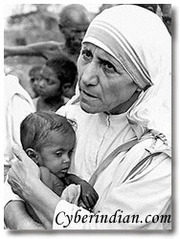When I read the word servant leadership, Mother Teresa immediately popped up into my head. It’s hard to imagine a celebrity who left home at 18 to pursue a religious life, gave up all her worldly possessions except for the simplest necessities of life: three identical outfits, a pair of sandals, and a tin washing pail to live and work among the poorest of the poor in a remote and unknown country.

Back to the servant eldership definition, Greenleaf (1970) stated the origin of this theory that the leader has a need/desire to serve others so that they can develop themselves and therefore perform to meet organizational needs. In turn, those followers develop into servants themselves to help others in the organization which again helps the organization perform. According to servant leadership theory, Mother Teresa is almost a perfect model of a servant leader. Mother Teresa was a charity worker in India and also a nun. She had a clear vision. She founded Missionaries of charity in Kolkata, India. For 45 years she was looking after the poor, sick, orphaned and dying. It was a pretty depressing job. She was a selfless servant leader who dedicated her whole life to making others lives better. Mother Teresa’s Missionaries of Charity had 610 missions in 123 countries which served people with HIV, leprosy and tuberculosis. She won the Nobel Peace Prize in 1979 and India’s highest civilian honor in 1980 for her humanitarian work. Thousands of people were inspired by her servant leader behaviors followed her footprint to contribute their life to the charity. Mother Teresa had always insisted that her followers live in the same poverty as the people they served. Just like what she said when she was awarded the Nobel Peace Prize: ” I am unworthy, I accepted the prize in the name of the poor. The prize is the reorganization of the poor world…By serving the poor I am serving Him.”
Today, more than 4,800 Missionary Sisters of Charity, about 400 Brothers, and thousands of volunteers continue Mother Teresa’s work in Calcutta and around the world. The Missionaries of Charity organizaton continues to grow and attract new followers. . It was Mother Teresa who said “I alone cannot change the world, but I can cast a stone across the waters to create many ripples.” That is the statement that joined millions of people in unity.
Greenleaf, R.K. (1970). The servant as leader. Westfield, IN: The Greenleaf Center for Servant Leadership.

Hi Yan,
I too view Mother Teresa as a prime example of the servant leadership theory. Her life followed all ten characteristics of a servant leader: listening, empathy, healing, awareness, persuasion, conceptualization, foresight, stewardship, commitment to growth of people, and building community (PSU WC, 2013 P3). She lead by example and dedicated her life to serving others while encouraging others to also give of themselves. Mother Teresa was endearing to the public even through the criticisms she persisted. She wanted to help others develop a relationship with God. A quote from a letter she wrote,” “Jesus has a very special love for you. As for me, the silence and the emptiness is so great that I look and do not see, listen and do not hear.” She also had questions within her heart but her belief prevailed.
References
Calhoun, A. (2013). The New York Times. Rooting for Mother Teresa. Retrieved from: http://www.nytimes.com/2013/07/13/opinion/rooting-for-mother-teresa.html?_r=0
Pennsylvania State University World Campus. Psych 485: Leadership in Work Settings. Lesson 11: Servant Leadership. Retrieved from htps://courses.worldcampus.psu.edu/fa13/psych485/002/content/11_lesson/01_page.html
Yan, your selection of Mother Teresa for servant leadership was spot on! She epitomized all that was pure in life, not just by the words she spoke, but also by the actions she took. Northouse (2013) points out “do those served grow as persons; do they, while being served become healthier, wiser, freer, more autonomous, more likely themselves to become servants?” (Loc.4196). This idea is supported by the fact that now 4,800 missionaries along with thousands of volunteers continue her work today.
Reference
Northouse, P. (2013). Leadership Theory and Practice [Kindle DX Version]. Retrieved from Amazon.com